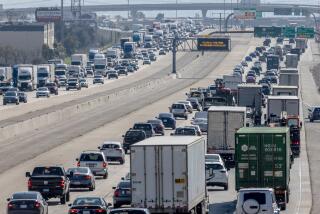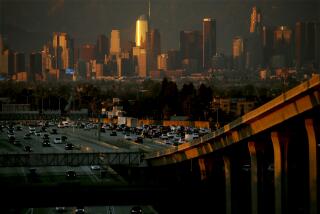Go ahead and hack.
IN the late 1940s, a Caltech chemist took time off from studying the sweet taste of pineapples to chase down a certain home-grown stink: the bleachy, eye-smarting, lung-burning air that had started to envelop Los Angeles.
On the worst days, ladies had taken to carrying cloths to mop their tears, and drivers had to pull over because their eyes watered too badly to see. Rubber tires cracked, nylon stockings decayed and farmers reported spots on the leaves of their prized citrus, spinach and beets.
A host of measures — notably the closure of a much-vilified wartime rubber plant — had failed to solve the problem, and outraged Angelenos had been badgering the newly formed L.A. County Smoke and Fumes Commission for answers.
They didn’t much care for what the chemist, Arie Haagen-Smit, had discovered: The principal culprit wasn’t industry, but cars.
Haagen-Smit distilled down hundreds of cubic feet of air and identified the eye-smarting culprits. Then, following a hunch, he took components of car exhaust — nitrogen dioxide and hydrocarbons — and exposed them to light. The brew was uncannily similar to the junk in the air — and seemingly just as noxious.
Leaves of plants discolored when subjected to it. Officials found that it stung their eyes, and one enthusiastic air pollution officer inhaled so much “Haagen-smog” that he got bronchitis.
It was a eureka moment, right up there with the invention of the Richter scale.
Smog. It’s as much a part of L.A. as celebrities, water-guzzling lawns and urban sprawl. Its light-reflecting particles give us those nice, blazing sunsets — the pretty “auburn sky” of Don Henley’s song “Sunset Grill” — and impart a glow to the city that caused one New Yorker essayist to tear up from emotion, not pollution, at its memory. Even a cosmetics line and a rock band have taken their names from it.
Tourists as far back as the 1940s bought canisters of Genuine Los Angeles Smog (adorned with depictions of cars and a haze-shrouded City Hall) to mail to their nearest and dearest. Children of the ‘70s played an earnest Smog board game in which they got to be little red-tape bureaucrats, moving tokens and plastic smoke plumes while trying to clean a city’s air.
Some of this was gallows humor, of course. Smog is nothing to take lightly — a fact that gets clearer each year as the ill effects of air pollution are better understood. Smog reduces lung capacity, and exacerbates asthma in children. Some elements of smog are carcinogenic, and no one knows how many people might die before their time from breathing it.
Its tendrils reach far beyond the city, as far east as Joshua Tree National Park, depositing nitrogen in the soil that encourages the growth of foreign weeds at the expense of native species.
Technically speaking, though, it’s really not smog that we’re talking about, points out Scott Dewey, a scholar and historian of foul air.
“It’s a misnomer,” Dewey says. The word “smog,” coined in 1905, is a melding of the words “smoke” and “fog,” and it refers more properly to the industrial emissions that killed 20 people (as well as sundry cats, dogs and canaries) in Donora, Pa., in 1948; and to the smoky, sulfurous coal-burning fog that killed an estimated 4,000 Londoners in 1952.
We never got much of that kind of smog, Dewey explains, because we didn’t burn much dirty coal, relying instead on cleaner oil and gas as the population burgeoned. Nonetheless, the region has always been prone to dirty air, and with it has come a certain bewilderment.
In one episode during World War II, the Japanese were suspected of staging a chemical attack. During another, a Los Angeles official suggested that the stinging eyes experienced by Altadena protesters were “psychological.” The official was invited by the Altadena Property Owners League to visit the city and “get lungs full of psychology.”
Officials rode blimps over the city to see whether they could spot the source of the pollution, and I.A. Deutsch, air pollution control director with the county Health Department, repeatedly urged residents experiencing stinging eyes from “aerial sewage” to send postcards detailing their experiences to City Hall.
We now know that L.A.’s famous inversion layer is a root cause of the smog problem. Warm air routinely settles above the cooler air blowing in from the ocean — and thus the cooler air cannot rise to dissipate its contents. Any emissions from chimney and tailpipe are trapped within the lowest few thousand feet.
Pollution regulators tried a host of other measures before they went after the auto: controlling dust and fumes at smelting plants, banning backyard trash-burning, slashing smoke from factories and sulfur dioxide emissions from refineries.
The public, too, weighed in with suggestions: As far back as 1960, for example, crusty Caltech astronomer Fritz Zwicky made the case for carpooling. “It is obviously preposterous to allow a single individual to pollute the atmosphere at his pleasure,” he wrote, adding that eradicating smog would show the Communists that America meant business.
Some tips from the public bordered on the absurd. One would have blasted holes through the San Gabriel Mountains and fanned the dirty air to the desert beyond. Another would have built a huge mirror to deflect sunlight upward, thus punching a hole through the inversion layer and permitting the smoggy air to dissipate.
Dewey’s favorite was a proposal to puncture the inversion layer by deploying a host of helicopters to hover over the city, churning up the air with their propeller blades.
Anything, it seemed, but give up the automobile.
Eventually, though, controlling smog came down to controlling the car — and gaining a greater understanding of just what makes up L.A.’s smog. Evaporating organic chemicals (from gasoline, paint, solvents, car exhaust and even eucalyptus trees) join oxides of nitrogen (from vehicle exhaust and power plants), and the two over the day are buffeted eastward by the off-ocean wind. As they ride, they react in sunlight to form a soup of chemicals, including rubber-eroding ozone.
Also riding are tiny particles derived from such sources as dust, exhaust, ground-up tires, cooking and barbecues. As the day goes on, the air gets worse and moves inland, peaking in nastiness at Santa Clarita or Crestline and Lake Arrowhead, home of the nation’s highest ozone levels.
We owe such understanding in part to the South Coast Air Quality Management District, whose spiffy Diamond Bar headquarters, right above the 60 Freeway, is slap in the middle of smogland. Guarding its air-testing labs are two decommissioned smog-monitoring machines that no one had the heart to throw out: a tin soldier-like contraption called the Cheney Autosampler Model 1 that was used to collect smog particles in the 1950s, and another with the look of a grandfather clock that once sampled sulfur dioxide.
Inside, fueled by coffee breaks at the district’s Blue Skies Cafe, technicians toil year-round monitoring the Southland’s air. A half-acre sea of benches is covered with automated machinery running tests around the clock. There are mass spectrometers, plastic bags and metal spheres filled with L.A. air samples, and a stack of brown envelopes holding collections of small particles.
A chemist is analyzing samples of minute particles: Peaks and troughs on a graph will tell him what toxic chemicals are present, and other tests will reveal what percentage came from vehicles, frying meat or even vegetation. It’s a far cry from the early days of L.A. smog science, when ozone was tracked measuring scabs on bean plants or how long it took for a rubber band to crack.
“Ozone has gotten dramatically better since the late 1970s — the last five, six years have been kind of flat in terms of the trend,” says Sam Atwood of the air-quality agency. “It’s not getting worse, but it’s certainly not improving at the same rapid rate that it was. Cars have cleaned up a tremendous amount. Today’s new car is 1,000 times cleaner than cars in the 1960s. But we still have 10 million vehicles.”
Today, the Southland still holds the nation’s record for dirtiness despite recent, stiff competition from its closest contenders, Houston and the San Joaquin Valley. Yet the air we breathe today is much improved, even with the steadily growing population: L.A. hasn’t had a Stage 1 smog alert since 2003.
The kind of air pollution we produce (derived from vehicle exhaust and other emissions that are simmered gently to maturity in the sunshine) is now typical in such cities as Denver, Bakersfield, Phoenix and Atlanta. Our city, it appears, may be in danger of losing a dubious distinction.
Yet Dewey thinks L.A. and smog will always be inextricably linked — in good ways as well as bad.
Despite our still-filthy air, he thinks L.A. has reason to be proud. The region was the first to present the problem of auto pollution to the world, and the first to show that city-by-city ordinances couldn’t fix the problem. It was the training ground for a host of air pollution officers who fanned out to take key positions in the federal government and cities nationwide, and the 800-pound gorilla that showed the need for a Clean Air Act that the whole nation benefits from today.
“Los Angeles and Southern California should carry the stigma of smog. It is where it all began, it became notorious and it still is notorious,” he says. But, Dewey adds, L.A.’s smog controllers “were the first to take it on, and they took it on with conviction. In a weird way, smog should almost be a badge of pride.”
*
(INFOBOX BELOW)
Bad air days -- 464 years of them
1542: Explorer Juan Rodriguez Cabrillo christens San Pedro Bay “La Bahia de la Fumos” — Bay of Smokes — for the way smoke from Indians’ fires hug the ground.
1868: The L.A. area’s 5,000 residents are perplexed by “an atmosphere so filled with smoke as to confine the vision within a small circumference.”
1901: An episode of dirty air is mistaken for an eclipse of the sun.
1905: First recorded use of the word “smog,” by physician Harold A. des Voeux, to describe London’s bad air.
July 26, 1943: After a series of bad-air episodes, visibility in downtown L.A. is reduced to less than three blocks.
1950s: Smudge pots (fires used to keep fruit trees warm at night) are banned.
1955: Highest ozone level — 0.68 parts per million in downtown Los Angeles — reported in the Southland.
1956: The first air-quality monitoring stations are established; today the Air Quality Management District has 35.
1958: Backyard incinerators are banned.
1966: California is the first in the nation to set auto emission standards.
1974 Creation of Stage 1 (bad), 2 (worse) and 3 (gasp!) smog alert system.
1975: South Coast Air Basin has 118 Stage 1 smog alerts. Catalytic converters are required on new cars sold in California.
1977: The South Coast Air Quality Management District, or SCAQMD, is formed; it now regulates air quality in 10,743 square miles populated by more than 16 million. 1995: The South Coast air basin has 14 Stage 1 smog alerts.
1999, early 2000s: Ozone levels in Houston are worse than L.A’s for several years running. L.A. recovers, and holds, its lead.
2006: The South Coast air basin has had no Stage 1 smog alerts since 2003, no Stage 2’s since 1988, no Stage 3’s since 1974.
*
Sources: SCAQMD, California Air Resources Board, “Don’t Breathe the Air” by Scott Dewey, Times research
More to Read
Start your day right
Sign up for Essential California for news, features and recommendations from the L.A. Times and beyond in your inbox six days a week.
You may occasionally receive promotional content from the Los Angeles Times.






